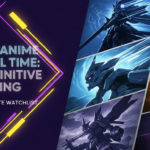Ever wondered about the difference between manga and anime?
If you’re an aficionado of Japanese pop culture, you’ve likely encountered both manga and anime. But the nuances between these two mediums can be subtle yet significant, leaving you puzzled about their distinct characteristics.
So, what is the difference between manga and anime? Manga is a form of Japanese comic book or graphic novel, usually in black and white, and read from right to left. Anime, on the other hand, is a type of Japanese animation, often in full color and viewed in episodes.
Intrigued? Stick around, because I’m about to dive deep into the world of manga and anime, unraveling their unique features, storytelling mediums, and adaptation differences. Whether you’re a seasoned fan or a curious newcomer, this comprehensive guide will equip you with everything you need to know about these captivating forms of Japanese cultural media.
Key Facts:
- Manga are Japanese graphic novels and comics, usually in black and white.
- Anime refers to Japanese animation, often in color.
- Manga is read right to left, while anime is viewed left to right.
- Manga has a faster pace, while anime is slower.
- Manga is more affordable than anime.
The Core Distinctions: Manga vs. Anime
Manga and anime have some clear differences as visual mediums. While both are iconic forms of Japanese entertainment, they each have unique attributes.
One of the most obvious differences is that manga is a print medium, usually published in black and white, while anime is animation, typically in full color. Additionally, manga is read from right to left, reflecting traditional Japanese writing direction. In contrast, anime is viewed left to right, like most TV shows or movies.
Manga is presented in chapters or volumes, allowing stories to be told through sequential panels and speech bubbles. Anime uses the format of episodes, taking advantage of motion and sound to bring stories to life.
When it comes to pacing, manga is frequently faster-moving and more condensed compared to anime. This allows manga creators to pack in more plot points and dramatic twists. Anime episodes need to fit into strict time constraints, so the story is often expanded with more scenes and dialogue.
Lastly, manga is generally more affordable, with full series collected in printed volumes costing less than purchasing anime seasons. However, anime allows audiences to experience the sounds, colors, and motion of a story – an effect manga cannot replicate.
What is Manga and How is it Unique?
Manga refers to Japanese comic books and graphic novels. The term encompasses all genres and demographics. Mangas are printed publications, usually in black and white.
The origins of modern manga can be traced back to the 19th century, but the iconic art style we recognize today emerged after World War II. Manga exploded in popularity across the globe from the 1960s onward.
Some unique aspects of manga include:
- Stories are read from right to left, reflecting traditional Japanese direction.
- Artwork is presented in detailed black and white drawings.
- The visual style uses exaggerated facial features and expressions.
- Text conveys dialogue in speech bubbles and narration in captions.
- Plots are fast-paced, often with cliffhangers between chapters.
Notable examples of popular manga series include One Piece, Attack on Titan, Naruto, and Death Note.
What is Anime and How Does it Stand Out?
Anime refers to Japanese animated productions featuring hand-drawn or computer-generated images. The term covers many genres and formats.
Modern anime emerged in the 1960s, influenced by manga and earlier animation works. It rose to international fame through series like Dragon Ball Z and Sailor Moon.
Distinctive qualities of anime include:
- Vibrant, colorful artwork produced by animation studios.
- A range of art styles depending on the creators and budgets.
- Viewed through episodes released weekly or seasonally.
- Visual humor, dramatic expressions, and action scenes.
- Adaptations of manga, light novels, or original stories.
Well-known anime series include Attack on Titan, One Punch Man, Demon Slayer, and My Hero Academia.
The Artistic Divide: Styles and Mediums
Manga and anime showcase the art of visual storytelling in different mediums: print and animation. This leads to varied art styles and techniques.
Manga leverages the creative possibilities of black and white illustrations. Limited only by their imaginations, manga artists use shading, textures, and line work to produce stunning visuals. Popular manga styles include shoujo (romance-themed) and shonen (action-oriented).
In contrast, anime utilizes dynamic, colorful animation. Anime art varies between studios and productions. Styles like moe (cute/young characters) and mecha (futuristic robots) have emerged. While manga has more creative freedom, anime benefits from motion and sound.
The mediums also impact storytelling pacing. Manga panels can jump through time and space. Anime needs fluid animation between scenes, influencing scene order and length. Both excel at impactful visual narratives.
Key Takeaway: Manga enjoys creative freedom using black and white drawings, while anime leverages motion and color in animations. This leads to different predominant art styles.
How Art Styles Differ in Manga and Anime
Manga and anime each have characteristic art styles, though there is overlap. As a print medium, manga art isn’t limited by production constraints. Signature styles have emerged to match different genres.
For example, shoujo manga uses soft, elegant character designs and decorative elements to convey romance. Shonen manga emphasizes dramatic action and intense emotions through bold lines and visual metaphors.
Anime art varies between studios based on budget, animators’ skills, and intended audience. Styles like chibi (cutesy, small characters) and harem (attractive love interests) have become prevalent in certain genres. Anime adaptations often simplify complex manga artwork for animation.
Regardless of medium, both leverage visual exaggeration to expressive effect. Large eyes, sweat drops, and speed lines enhance drama. While styles differ, vibrant artwork remains integral to manga and anime’s appeal.
Medium: Print vs. Screen
Manga is presented in print form such as comic books and graphic novels. Anime is produced for television broadcasts and home video.
This affects how audiences engage with the works. Manga requires actively reading panels and imagining action in one’s mind. Anime presents animated footage for passive viewing.
For manga creators, artwork and text must be clear when printed in black and white. They utilize creative panel layouts and visual metaphors. Anime studios incorporate colors, camerawork, voice acting, sound effects and music into a dynamic viewing experience.
Anime adaptations sometimes suffer from issues like rushed animation or filler content to meet runtime. Manga lets creators set their own pacing. Both mediums have advantages in engaging audiences through visual storytelling.
The Pace and Narrative: Storytelling in Manga and Anime
Manga and anime take different approaches to storytelling and narrative pacing. This stems from how content is produced and consumed.
Manga chapters are released weekly or monthly in magazines and volumes. This allows for faster pacing, cliffhangers, and suspense. Anime episodes have length requirements and seasonal constraints, so adaptations often expand stories.
Plots in manga usually stay closer to the author’s intent. Anime studios may alter narratives to fit production limitations. Ultimately, the mediums have complementary strengths in creative storytelling.
Tip: Manga’s serialized chapters encourage brisk pacing, while anime episodes better showcase action but may expand stories.
Why Manga is Generally Faster-Paced
The publication format of manga enables brisk, dense storytelling. Manga chapters are around 20 pages released weekly or monthly in magazines, then compiled into volumes.
Working within these constraints, manga creators use compressed narratives. Stories jump quickly between scenes and focus on impactful moments. Cliffhangers and emotional peaks keep readers eager for the next chapter.
This faster pace allows manga series to build expansive worlds and narratives over decades of publication. Famous series like Golgo 13 and One Piece have run for over 50 years!
Anime adaptations must then condense story arcs into episodes and seasons. This often results in a slower pace to fully animate important scenes from the manga. So manga provides greater creative freedom for fast-paced, serialized narrative.
Fidelity to Source Material: Adaptations and Variations
Manga stories are often adapted into anime series, but sometimes with alterations to the original narrative. This stems from the limitations of animation production.
Manga creators have flexibility in storylines, settings, action, and characters. Anime studios must work within budgetary and time constraints.Complex manga artwork may be simplified or action condensed to fit episode length.
Certain story arcs may be reordered, shortened or expanded in the anime adaptation. More anime-original filler content helps prevent the show from passing the manga’s storyline.
That said, successful adaptations like Jujutsu Kaisen faithfully recreate pivotal manga scenes. Changes are sometimes necessary for adaptation, but often respect the source material. Audiences can enjoy both versions of a great story!
Affordability and Accessibility: Where to Find Manga and Anime
Manga volumes provide an affordable way to enjoy these stories compared to purchasing anime Blu-rays or episodes.
Popular manga is widely available in dedicated sections at bookstores like Barnes & Noble and Kinokuniya. Local comic book shops may also carry manga, though selection varies. Large online retailers offer extensive manga catalogs at competitive prices.
Anime was once only accessible through expensive DVDs and Blu-Ray box sets. The rise of streaming services like Crunchyroll and Funimation has made current anime more affordable and convenient to watch.
Both mediums have content spanning all age ranges and maturity levels. A benefit of manga is the ability to enjoy tactile, offline reading. Anime allows viewers to experience moving animation and voice acting. There are pros and cons to each approach.
FAQs About the Difference Between Manga and Anime
Q: How different is the manga from the anime?
A: There can be moderate to significant differences. Anime adaptations face production limitations, which may result in simplified art, condensed stories, changed order of events, or filler content. The manga likely retains a faster pace and more details.
Q: Which is better: anime or manga?
A: This is entirely subjective! Some may prefer anime’s animation, color and convenience on streaming services. Others enjoy manga’s tactile experience, faster pacing, details and fidelity to the original story. It comes down to individual tastes.
Q: What is the difference between manga and anime One Piece?
A: As one of the longest-running manga, the One Piece anime adapts only a portion of the full story so far. To avoid filler, the anime expands events and slows the pace. The manga has more details, faster pacing and intricate artwork untouched by production limitations.
Q: Is manga and anime the same story?
A: Sometimes yes, sometimes no. Many anime are direct adaptations of manga stories. But anime productions face constraints requiring changes, from art style simplifications to reordered or expanded narratives. The core story may stay intact, but key details often differ.
Summary
Manga and anime represent two complementary mediums of Japanese storytelling, each with unique advantages. Manga leverages bold black and white graphics, unhindered creative freedom, brisk pacing and tactile reading experience. Anime utilizes motion, sound and color animation to bring stories to the screen.
While anime adaptations may diverge from source manga, they expand accessibility. In the end, the vibrant worlds of manga and anime provide engaging experiences for audiences worldwide. Fans can discover which medium resonates with their personal tastes.
The intricacies between manga and anime run deep. But hopefully this guide has illuminated their key distinctions – from reading direction and art styles to story pacing and affordability. Now you’re equipped with the integral knowledge to dive deeper into these cultural icons from Japan. Keep exploring the captivating worlds of manga and anime.



